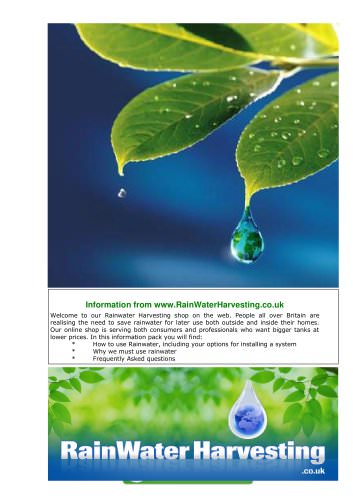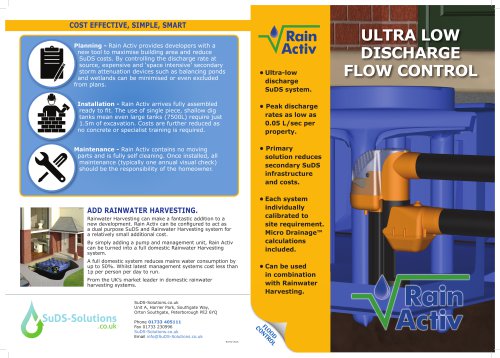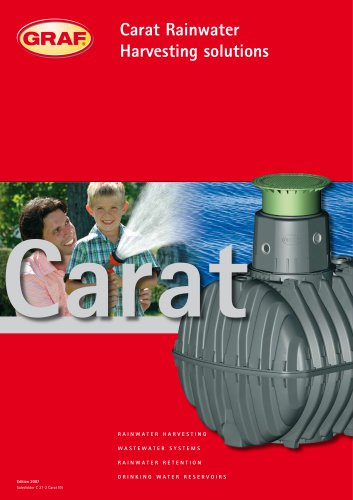
Catalog excerpts

Information from www.RainWaterHarvesting.co.uk Welcome to our Rainwater Harvesting shop on the web. People all over Britain are realising the need to save rainwater for later use both outside and inside their homes. Our online shop is serving both consumers and professionals who want bigger tanks at lower prices. In this information pack you will find: * How to use Rainwater, including your options for installing a system * Why we must use rainwater * Frequently Asked questions Rainwater Harvesting.co.uk Information pack November 2008 V4 1
Open the catalog to page 1
Welcome To Our Rainwater Harvesting Shop We want you to benefit from your own rainwater coming off your own roof. Doing this you will conserve and make better use of the world’s most precious resource. You don’t need drinking quality water bought in from miles away to clean your car, wash the patio or fill a pond. You don’t need drinking water to flush WCs or in the washing machine. And your garden much prefers chemical-free rainwater. In fact, use rainwater whenever you don’t need drinking-quality water. Use Rainwater in the Home Most of us have been using small water butts in the garden...
Open the catalog to page 2
We offer a range of tanks adaptable to different locations: wall tanks that fit neatly against the house, slim tanks (the Water Hog) that take up little space, feature tanks that disguise their function as a wall or rock, and much larger tanks that can be installed above or below ground. Most of our tanks and accessories come from Germany where rainwater harvesting has been well-established for several years. Components of a rainwater harvesting set-up : 1. A water butt (normally thought of as a smaller one located at the down pipe from the roof) or storage tank (of larger capacity located...
Open the catalog to page 3
7. The Calming Inlet, lying at the bottom of the tank and fixed to the inlet pipe, prevents any debris accumulated on the tank bottom from being disturbed by water flowing in. 8. To use rainwater inside the house a mains back-up system is necessary in case the tank empties. You may want a mains backup for outdoor use also, particularly if a timed irrigation system is connected to the rainwater tank. See paragraph 1.4 below for choice of 3 options. All options must safeguard against any rainwater ever entering the mains drinking water network, which is required by Building Regs. 9. There is...
Open the catalog to page 4
We supply all the accessories needed, such as connectors for storage tanks to fit into house or shed drainpipes, and pumps to create a better flow. Remember plants prefer rainwater to mains water: it is softer and has no added chemicals like chlorine. 1.2 Household and Garden systems Installing a much larger tank capturing rain from a full roof has two advantages; 1) it provides more security for the garden in drought conditions and 2) can also be used to clean cars and even to supply WCs and washing machines. Typically, an average household will need at least a 3000 litre tank or bigger...
Open the catalog to page 5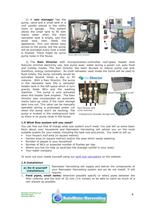
2) A rain manager has the pump, valve and a small tank in a unit usually placed in the utility room or garage. This system allows the small tank to fill with mains water when the main rainwater tank is empty, and this small tank then feeds the appliances. This unit allows easy access to the pump, but the pump will be activated every time a toilet is flushed. There might be some pump noise in the house. 3) The Rain Director with microprocessor-controlled roof-space header tank features minimal electricity use, less pump wear, water during a power cut, auto flush and holiday modes. The Rain...
Open the catalog to page 6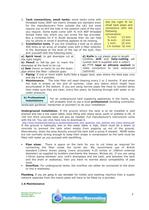
2. Tank connections, small tanks: some tanks come with Get the right fit for threaded holes (BSP not metric threads are standard even small tank pipes and for the manufacturers from outside the UK) but most connectors with the require you to drill the hole in the position (and of the size) following you require. Some butts come with ¾ inch BSP threaded conversions: female holes into which you can screw the tap provided. ½ inch: 13 mm Buy a complete kit if in doubt because then we can help ¾ inch: 19 mm you by phone or email if anything appears to be missing. 1 inch: 25 mm 3. Installation...
Open the catalog to page 7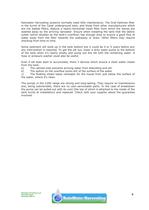
Rainwater Harvesting systems normally need little maintenance. The Graf Optimax filter in the turret of the Carat underground tank, and those from other manufacturers which are not basket filters, feature a nearly-horizontal mesh filter from which the leaves are washed away by the arriving rainwater. Ensure when installing the tank that the debris outlet (which doubles as the tank's overflow) has enough drop to ensure a good flow of water away from the filter towards the soakaway or drain. Other filters may require checking from time to time. Some sediment will build up in the tank bottom...
Open the catalog to page 8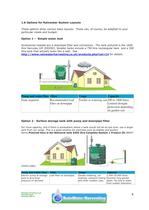
1.6 Options for Rainwater System Layouts These options show various basic layouts. These can, of course, be adapted to your particular needs and budget. Option 1 – Simple water butt Accessories needed are a downpipe filter and connectors. The tank pictured is the 1600 litre Hercules (GF 200200). Smaller tanks include a 750 litre rectangular tank and a 300 litre tank that actually looks like a wall. See http://www.rainwaterharvesting.co.uk/products.php?cat=14 for details. Pump and water flow Filter None required Recommended Leaf filter on downpipe Usage Capacity Trickle or watering can 200...
Open the catalog to page 9
Option 3 - Small butt and surface storage tank with pump Where it is impractical to put a large tank near the roof collecting the rainwater, a small tank can be located near the roof and the large tank placed at a distance. Pump and water flow Electric pump at house tank with float switch and pump at large tank to deliver pressure at the hose or tap. Filter Best with leaf filter on downpipe and floating intake on the large tank outflow. Usage Capacity 1,000-30,000 litres. Tap, irrigation supply, Summer long garden trickle or watering can. Power washing, pond water. Some loss of water top up...
Open the catalog to page 10
Option 5 - Below ground storage tank Putting the tank underground is the preferred solution but incurrs the extra installation cost. You can weigh up the arguments for and against underground installation. 1) in favour of digging the tank in: a) No unsightly equipment in the garden, especially if you are installing a tank bigger than 200 or 360 litres b) Suitable for a small garden or where the space is otherwise restricted. For example, our stronger tanks can be installed under a drive way if suitable supports are constructed over the tank c) Less risk of brackishness in summer due to...
Open the catalog to page 11All RainWater Harvesting catalogs and technical brochures
-
Rain Activ
2 Pages
-
F-Line Shallow Dig Tanks
2 Pages
-
rain backup in a box
3 Pages
-
HydroForce
2 Pages
-
Rain Director® brochure
3 Pages
-
Rainwater H2OG
1 Pages

